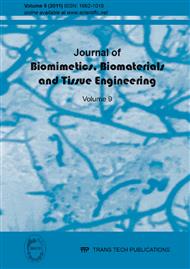p.1
p.17
p.25
p.37
p.47
p.57
p.69
p.81
p.93
Synthesis and Characterizations of Thermo-Sensitive Graft-Polymer Hydrogel from Gleditsia sinensis polysaccharide
Abstract:
The thermo-sensitive graft-polymer of Gleditsia Sinensis polysaccharide with N-Isopropyl Acrylamide (NIPAM) was prepared and cross linked with glutaraldehyde to form the hydrogel. The effect of reaction conditions on the graft rate and gel strength of Gleditsia Sinesis Polysaccharide-g-NIPAM was evaluated. The graft rate of Gleditsia Sinensis polysaccharide reached the highest value with temperature of 75°C, reaction time of 5 hours and initiator of 0.025% (ratio of initiator to hydrogel, w/w) respectively. The gel strength of hydrogel, generated by the graft-polymer using glutaraldehyde as a cross linker, had a negative correlation with the grafting rate of the polymer. The influence of ionic strength and concentration of cross linker on gel strength, contractibility and Equilibrium Degree of Swelling (EDS) were investigated. The contractibility and gel strength increased with increments of cross linker and NaCl concentration, while EDS decreased with the increasing amount of cross linker and NaCl concentration. FT-IR and XRD were employed to confirm the grafting reaction between NIPAM and Gleditsia Sinensis polysaccharide. There was a great difference of contracting behavior between the thermo-sensitive hydrogel and ordinary hydrogel, which was mainly manifested by the temperature reaching the Lower Critical Solution Temperature (LCST) of the polymer. The amount of water released from the thermo-sensitive hydrogel per unit time was much more than the ordinary hydrogel, which was mostly due to the conformation transition of the graft-polymer. It was found that the LCST of the polymer was obtained at 36.5°C, which indicates that the polymer has an obvious temperature dependency and could be used in living tissues as drug controlled release materials.
Info:
Periodical:
Pages:
57-68
Citation:
Online since:
January 2011
Authors:
Price:
Сopyright:
© 2011 Trans Tech Publications Ltd. All Rights Reserved
Share:
Citation:


